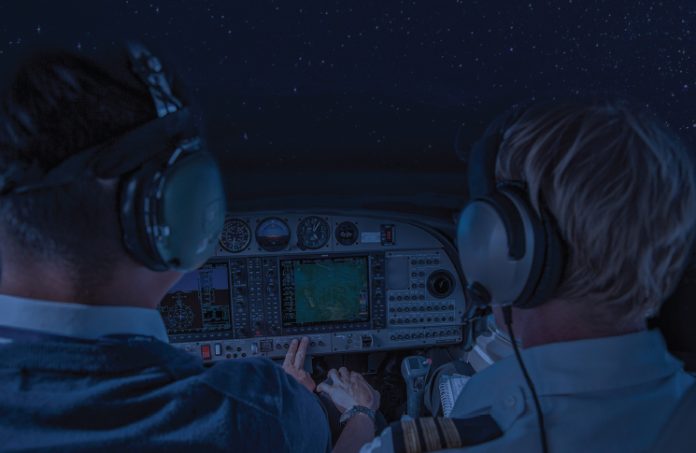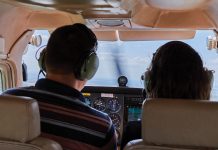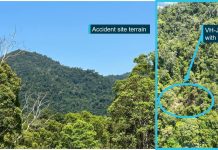On a very dark night, not understanding an engine’s operating characteristics almost led to disaster.
I am a flight instructor for a flying club located at Innsbruck Airport, Austria. In addition to PPL courses, we offer night VFR training on a Diamond DA40.
One part of the required flight training is a cross-country flight, which we always do to a nearby controlled airport – Salzburg – because it has suitable opening times and lighting and is conveniently located about 45 minutes away. We use this flight to show students the peculiarities of approaching an airport other than their home airport, visually by night.
On this particular evening in December 2011, I was scheduled to fly with a relatively experienced private pilot, Stan, who wanted to upgrade his licence to night VFR.
The sky was clear on the entire route; however, it was a cold and rather dark winter night. Due to the known additional risks associated with single-engine night flying, I only do these flights on an aircraft in perfect technical condition and along the safest route. Both Innsbruck and Salzburg are located in mountainous terrain and I always choose the route that is a bit longer but leads over flatter terrain for most of the distance and also follows a motorway.
After a thorough pre-flight inspection, Stan and I departed Innsbruck at around 6 pm and had an uneventful flight at 9,500 feet AMSL until approaching our top of descent.
From my previous flights, I knew that approaching Salzburg Airport by night from the west for the first time can be stressful for students as the terrain and navigation along that VFR arrival route are challenging. My intention was to perform a low-rate descent to still have enough altitude to enable us to reach our destination airport, even with an engine failure. At that time, we were on the part of the route where neither our departure, the destination nor any other airport with night lighting, was within gliding distance.
Stan initiated the descent and then a period of 2 minutes began which I cannot recall to this day. I guess I was busy checking the terrain below us for some suitable engine-out landing opportunities as I usually do, or maybe I was thinking about something completely different. For some reason, the 2 minutes have been erased from my memory.
He moved the lever to the forward stop but everything remained much too silent and the airspeed began to reduce.
The next thing I remember is looking at the flight instruments and noticing we had performed a very steep descent and were already passing 6,000 feet. I asked Stan to stop the descent at 5,500 feet; he levelled off and tried to add power. However, when he pushed the throttle lever forward, there was no response from the engine. He moved the lever to the forward stop but everything remained much too silent and the airspeed began to reduce.
I looked at the digital engine instruments. All were indicating in their normal range, illuminated green. On our turbocharged diesel DA40, power is adjusted by simply setting a percentage of maximum power. The power indicator showed 27% although the power lever was at the forward stop.
After a short moment of disbelief, I said, ‘My controls’ and, as I suspected some problem with the connection of the power lever to the engine control unit, pulled the lever completely back and then pushed it forward again. Nothing changed. As we had slowed to best glide speed, I had no choice than to start descent towards a very black earth.
I asked Stan to get the emergency checklist out as a life-threatening night landing into black unknown terrain, which I had always pointed out as the worst-case scenario during the theoretical course, now became reality.
I decided to call ATC to get help on the ground as soon as possible. I declared an emergency and, as we had no chance to reach any airport with lights from our position, informed the controller that we would initially turn towards the lower terrain to the north.
We had already discussed emergency landing options during cruise flight but had only been able to identify some generally more suitable areas, not any specific fields, as the night was too dark to distinguish ground features.
As we still seemed to have 27% of power, I thought our problem was a partial loss of power rather than a complete engine failure. I had already performed a few of the emergency procedure items when Stan joined in and confirmed them. I opened the alternate air inlet, switched the engine control units and checked the fuel supply.
There was one step left, which was switching off the power to both engine control units and then on again to perform a reset. However, the question of where to land urgently needed an answer as we were descending through 4,000 feet. To our left was the big lake we had passed to the south just a few minutes ago. Its contours were, contrary to all other ground features, quite easily identifiable.
After a short discussion of our options, we agreed to take the water near the south shore of the lake as our landing area. We knew a water landing at night was very risky, but so was a landing on the ground where we had no idea about the surface or any obstacles like trees, masts or unlit houses.
I told the controller about our intentions and requested emergency services in the area to be dispatched.
Having made that decision and being on a long final approach to the lake, there still was one thing left to try – resetting the engine control unit. As I reached to perform the reset, the engine suddenly began to stutter and then almost immediately went to full power, as the power lever still was at the forward stop according to the abnormal procedure.
I started a climb and turned back to Salzburg Airport. We requested a climb from ATC to as high as we could do in the remaining distance and to proceed directly to short final. We were cleared accordingly and climbed to 7,000 feet until close to the airport. Then I began a power-on descent, with application of full power about twice a minute, to check the engine’s responsiveness and keep it from cooling down too much.
When we taxied off the runway after a normal landing, I suddenly felt something like fear for the first time and my feet began to tremble. Stan later said he also felt completely calm throughout the emergency, but only realised how close we had come to a disaster after we had landed.
We parked the aircraft and went home by train. A mechanic downloaded the engine data the next day and found we had descended with idle power for 2 minutes. According to the aircraft manual, this can lead to an engine failure in cold air – a fact both Stan and I knew but he simply didn’t think about when he performed the descent and I, as the instructor, failed to supervise him.
Lessons learnt
So we both made a mistake that night but fortunately, one we could learn a lot from. I have learnt that no matter how well a student performs, I have to be alert every second of the flight.
What we both learnt is that before starting any checklist or attempt to solve a problem, you first must be clear about its actual nature. By cross-checking all engine instruments, we would have been able to determine that it was indeed an engine failure and not a partial loss of power as the fuel flow gauge was showing zero. Seeing still some power output (which according to the engine manufacturer may happen in this case), we immediately started troubleshooting a problem we did not actually have.
When the engine started again the power lever was full forward according to the power loss checklist, when in fact it should have been on idle according to the engine restart procedure, which could have reduced the probability of a successful restart.
If I had looked at the fuel flow gauge, I would have been able to notice the actual problem. Given the fortunate outcome, it was the most valuable night VFR lesson for both of us.
Have you had a close call?
Often the experience is something you’ll never forget and you’ve learnt a valuable lesson. Why not share your close call so others can learn from it too?
Articles should be between 500 and 1,000 words. Email fsa@casa.gov.au with your story or a request for a call back. If we publish your story, we’ll give you $500 for an article you’re written or $250 for a story over the phone.
Disclaimer
Close calls are contributed by readers like you. They are someone’s account of a real-life experience. We publish close calls so others can learn positive lessons from their stories, and to stimulate discussion. We do our best to verify the information but cannot guarantee it is free of mistakes or errors.





